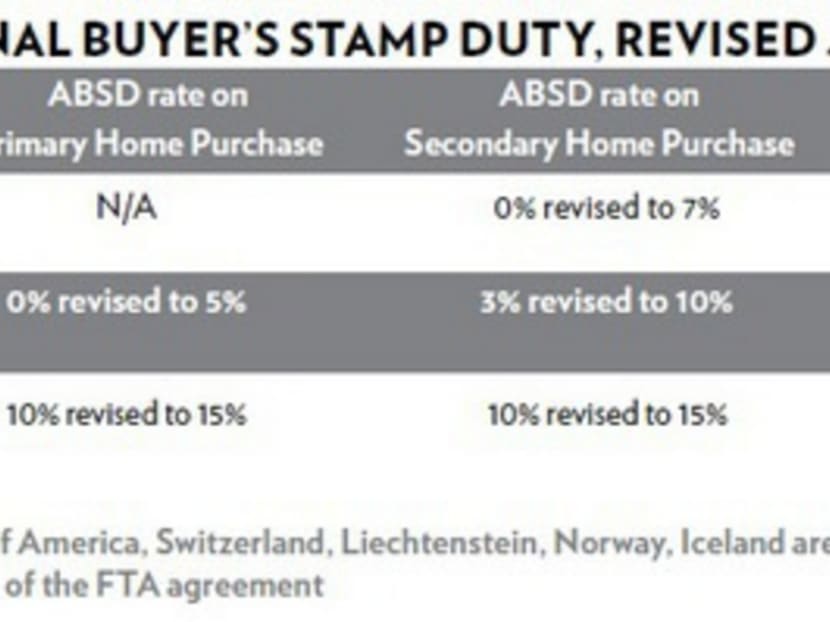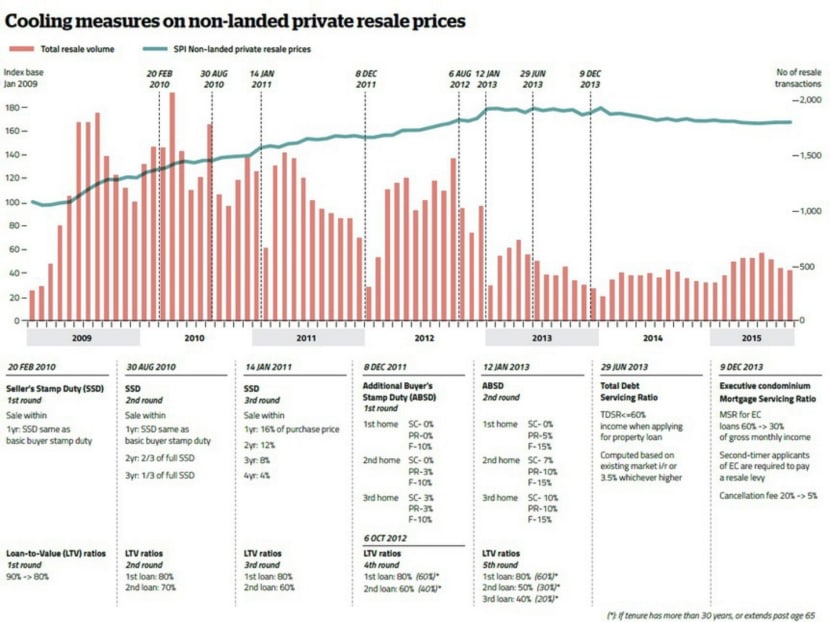ABSD has outlived its usefulness
A common argument against removing the Additional Buyer’s Stamp Duty (ABSD) is that it will undo the stabilising effect of the property cooling measures. The doomsday scenario is that a flood of overseas speculators will rush into the property market and drive home prices to unaffordable levels.


A common argument against removing the Additional Buyer’s Stamp Duty (ABSD) is that it will undo the stabilising effect of the property cooling measures. The doomsday scenario is that a flood of overseas speculators will rush into the property market and drive home prices to unaffordable levels.
This view overstates the negative externalities of the ABSD while failing to acknowledge the success of subsequent measures and structural changes, which have strengthened the property market’s resilience to instability.
The ABSD was not the Government’s first cooling measure. Three versions of the Seller’s Stamp Duty (SSD) and three changes to Loan-to-Value (LTV) ratios came before the first version of ABSD was introduced late in 2011. The sequence of the cooling measures suggests that the Government recognised that the ABSD was controversial but felt it had no choice.
The earlier measures were not bringing down prices, and the Government likely needed to buy more time for supply to come online.
The ABSD was always an imperfect short-term solution and its continuation undermines the very spirit of Singapore’s free market principles. By its very structure, ABSD treats groups of people differently and sends the wrong signal to Singaporeans, permanent residents (PR), and foreigners who want to invest in Singapore for all the right reasons.
The threat to Singapore’s economic stability is not long-term investors and fair-market property prices. The real threat is unaffordable housing, excessive consumer debt and a protected private property market that discourages capital investment in Singapore. In all three cases, other policy measures have proven to be more effective and equitable than ABSD.
There were three primary reasons for the run-up in property prices after the global financial crisis: Demand outpacing supply, record cheap financing and overseas capital seeking a safe haven in Singapore.
SUPPLY
The ABSD cannot solve shortages in housing stock because it does not add units to the market or subtract units from it. Instead, the ABSD tries to bring down prices indirectly by reducing demand. It does this by making housing more expensive to selected buyers. Unfortunately, this temporarily distorts market pricing without altering the fundamentals. As a result, it cannot be a long-term solution.
SRX Property’s graph on the cooling measure shows that the ABSD was very effective in reducing the number of transactions, but it struggled to bring prices down. In fact, the first round of ABSD, which only affected foreigners, did not bring prices down after its implementation in December 2011. It was not until the Government revised the ABSD in January 2013 and expanded the tax to include Singaporeans and PRs that prices began to slow.
Yet ABSD 2 cannot reduce prices in the long-run. The reason is simple: The market understands the value of homes. When sellers recognise that they cannot achieve fair market value, they sit on the sidelines. As such, homeowners who sell are those who must or those who sell to a buyer not affected by the ABSD. All the ABSD can do is buy time while supply catches up. When prices are too high because of a housing shortage, the only solution is to build more homes in order to re-establish a lower market equilibrium price.
Housing shortages create affordability issues. Since the ABSD cannot permanently bring down prices during housing shortages, it cannot solve problems of unaffordable housing. Again, only sufficient supply can make housing affordable in the long run. Subsidies can help but they do not alter the fundamental value of the home.
Now that supply has had time to come online, the ABSD is no longer needed. Rising vacancy rates indicate that there is now sufficient supply to accommodate demand, especially given the constraints of Total Debt Servicing Ratio (TDSR) on borrowing. Even if one does not agree that the market has achieved a sufficient level of supply, it is difficult to understand how market prices would suddenly go haywire and shoot above fundamental values if the ABSD is removed.
First, today’s market is more than capable of properly pricing homes without the help of the ABSD. Thanks to the Government, the real estate industry and technology companies, market participants have access to big data and valuation tools such as SRX’s X-Value. They are more than capable of anticipating supply in the pipeline and factoring it into their pricing. To not acknowledge these new efficiencies in the market negates public-private efforts to introduce transparency as a way to prevent housing bubbles and help stabilise the market. This more transparent and efficient market now has self-stabilising mechanisms that renders older measures, such as the ABSD, obsolete.
FINANCING
The second reason that prices are unlikely to soar is the TDSR that was introduced in June 2013. It has removed much of the underwriting risk in the market.
In his book, Hidden in Plain Sight, Mr Peter Wallison, a member of the US Government Financial Crisis Inquiry Commission (2009-2011), identified poor underwriting standards as one of the primary causes of the US housing crisis.
He writes: “It is clear beyond doubt that good underwriting standards produce a stable housing market during normal (non-stressed) times, while deviations from these standards produce instability and high rates of mortgage default. A decision to loosen underwriting standards as a matter of deliberate US government policy was a serious error”.
Unlike US policymakers, the Monetary Authority of Singapore (MAS) prudently tightened underwriting standards as a pre-emptive measure to stabilise the financial system. It was clearly concerned that in the price run-up after ABSD 1, particularly in the primary property market, consumers had taken on too much debt and would end up in dire financial straits if interest rates were to rise.
The TDSR gave the market a two-for-one. Not only did it impose some degree of sanity on a local market over-stimulated by low interest rates, it helped dampen demand in a productive way by taking people out of the market if they could not afford it. The TDSR did it in a way that focused on affordability not buyer passport.
OVERSEAS CAPITAL
The third reason the private condo market will not get out of control — even if you believe there is insufficient supply — is that reopening the market to overseas capital is highly unlikely to cause a run-up in prices and certainly not one that would make the mass market unaffordable.
In 2012, the ABSD 1 reduced foreign investment from about 22 per cent of total private apartment transactions to 6 per cent, yet prices continued to increase rapidly. Why? First, developers discounted new projects in response to the ABSD. Second, local buyers saw an opportunity to take advantage of low interest rates, discounted new homes and reduced competition from foreign buyers.
In short, it was mainly Singaporeans who drove up private apartment prices, not foreigners. As such, given the increases in supply, transparency, underwriting constraints, and the true cause of the previous spike in pricing, it is difficult to understand how restoring market pricing to foreign capital by removing the ABSD would result in uncontrollable price increases.
For those of us who are worried about combating speculation and hot money, the SSD is a much better remedy than the ABSD. The SSD attacks the root cause of speculation by imposing a holding period on property. Furthermore, long-term investors are used to lock-in periods, especially those with investments in private companies. They can live with the SSD because it is easier to manage back-end risk than the high return-on-investment (ROI) hurdle caused by the ABSD.
Ironically, this means that the ABSD deters good investment but does not necessarily stop shady overseas capital. Money launderers are accustomed to paying high transaction costs and are not deterred by high upfront taxes.
FOR THE GOOD OF SINGAPORE
Up until now, I have presented the technical arguments for why it is safe to remove the ABSD: A better pricing equilibrium thanks to an increase in supply, a more transparent and efficient market, consistent mortgage underwriting, and measures that prevent speculation.
There is also a compelling strategic reason for lifting ABSD. The ABSD sends a bad signal to investors. The fact is that Singapore is an open economy fully integrated with the world. As the MAS said in its October Macroeconomic Review, the economy is primarily export-driven, which means its customers are the world. According to the Ministry of Manpower and SRX Property calculations, foreign workers make up 38 per cent of Singapore’s working population. By my count, Singapore hosts the Asian headquarters for 319 companies in the global Fortune 500. Yet, the ABSD says that Americans can purchase Singapore property in accordance with the same rules as Singaporean citizens but Britons cannot. Is that the right signal to send?
The ABSD is a cooling measure that has outlived its usefulness. It is time to remove it and show the world that we have built a more efficient and stable property market that operates a free-market pricing mechanism that rewards long-term investment.
ABOUT THE AUTHOR: Jeremy Lee is Co-Founder and Chief Technology Officer of SRX Property, an information exchange formed by leading real estate agencies in Singapore to disseminate market pricing information and facilitate property listings and transactions. For more details on the Cooling Measures used in this article, visit SRX.com.sg/cooling-measures.





